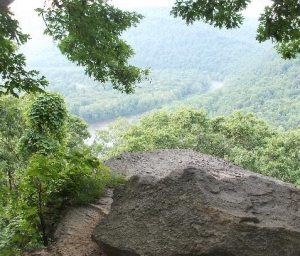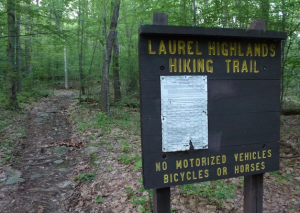Test Yourself — Wilderness First Aid Scenario
On a sunny, very hot and humid day in early August, you are hiking along the Laurel Highlands Hiking Trail when, at about 3:30, you spot up ahead two hikers who look to be resting in the shade. As you approach them, one of them asks if you have any medical training. Hesitantly, you acknowledge that you are Wilderness First Aid certified (and you suddenly begin to perspire a bit more heavily than you did a minute before). She then explains that her companion, Robert, has grown increasingly ill over the last hour and she isn’t sure if he should be evacuated or if he can continue to their planned shelter site.
You introduce yourself to Robert and with his consent you begin your assessment of him after putting on your blue nitrile gloves. Robert, who is 42 years old, complains that he is feeling nauseous and even vomited 30 minutes earlier; he has a pounding headache (that he rates a 6 on the 10 scale); and that he is fatigued and weak. You take the pencil and pad from your first aid kit and, and after marking the time (1544), you record his level of consciousness (A&O x4); his pulse (68 bpm); respiration (16 rr); and note that his skin feels normal but continues to be very sweaty (even in comparison to yourself and his companion).
 As you continue your assessment, you learn that Robert is allergic to penicillin, and that he takes vitamins and herbal supplements daily. He has no pertinent past medical history, denies any history of cardiac problems, and looks otherwise to be in good shape. Robert explains that the two of them have been hiking since early this morning and that they have already covered about 12 miles, much of it marked by particularly hilly terrain. When you ask if he has been drinking enough water, Robert responds defensively that “of course” hydration has been his biggest priority and, as such, he hasn’t even really felt thirsty all day – In fact, he has been urinating normally and it has been clear (a sign of proper hydration). John ate a bowl of oatmeal for breakfast, and an apple and banana for lunch.
As you continue your assessment, you learn that Robert is allergic to penicillin, and that he takes vitamins and herbal supplements daily. He has no pertinent past medical history, denies any history of cardiac problems, and looks otherwise to be in good shape. Robert explains that the two of them have been hiking since early this morning and that they have already covered about 12 miles, much of it marked by particularly hilly terrain. When you ask if he has been drinking enough water, Robert responds defensively that “of course” hydration has been his biggest priority and, as such, he hasn’t even really felt thirsty all day – In fact, he has been urinating normally and it has been clear (a sign of proper hydration). John ate a bowl of oatmeal for breakfast, and an apple and banana for lunch.
What do you think might be wrong with Robert?
Should he be evacuated, or can he finish his hike?
What do you do?
Don’t peek at the answer below until you’ve fully thought it out!

Diagnosis
Robert is likely suffering from hyponatremia.
Definition
Hyponatremia results when the blood sodium level falls too low to maintain normal body functions. While this can occur in a variety of ways, in the outdoors context it usually results from drinking more than enough water while failing to eat enough (which would help maintain sodium levels). It is often referred to as “water poisoning,” but this is a misnomer since it implies one drinking huge quantities of water, when really one can simply be drinking otherwise normal amounts.
While this may sound like a really obscure illness (and a trick medical scenario) it is more common than many realize. It may typically be seen in those who are engaged in rigorous activities, especially when it’s hot, like running, biking, adventure racing, even hiking. In short, the kind of activities in which many of us plan to engage this summer, alone or with friends.
It is too often mistaken for other heat related maladies, in particularly dehydration and heat exhaustion, and treated as such — the result of which can have nasty consequences for your patient.
Signs & Symptoms
Common complaints include nausea, vomiting, headache, weakness, fatigue, and muscle weakness. Vitals may include sweaty skin, normal core body temperature, normal or slightly elevated pulse, and normal or slightly elevated respirations. More severe symptoms can include diminished mental status, irritability, difficulty walking and maintaining balance. This condition may be fatal.
Treatment
Strong patient assessment skills are important so that you can best treat your patient.
Patients with normal mental status, and mild to moderate symptoms, may be treated in the field: Don’t give your patient any more fluids for the time being; rest in the shade; encourage a gradual intake of salty foods (like pretzels, crackers, or salted fruit slices), while the kidneys reestablish a sodium balance. Potato chips and nuts aren’t recommended due to their high fat content, and salt tablets are also not advised since they can induce nausea and vomiting. Continue to monitor your patient’s vital signs. Once your patient develops hunger and thirst combined with normal urine output, the problem is solved.
A patient with a deteriorating mental status needs to be evacuated immediately.
Wrap Up
While it’s certainly important to have proper training in wilderness first aid issues if you spend time in remote locations, what’s most valuable about having the necessary skills and knowledge isn’t so much about being able to treat a problem, but being able to prevent the problem in the first place.
In short, prevention is the best medicine!
—————–
You were completely surprised by this malady? You want to know more? Then consider enrolling in a Wilderness First Aid (WFA) certification course at True North. Our experienced instructors offer training to individuals and to private groups that are easy on your busy work schedule and pocketbook.

